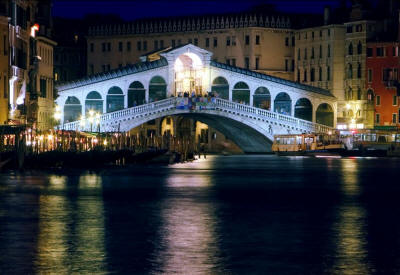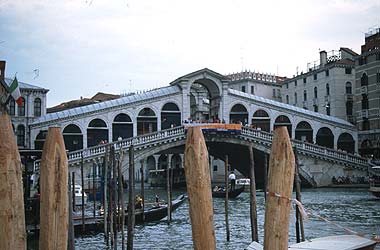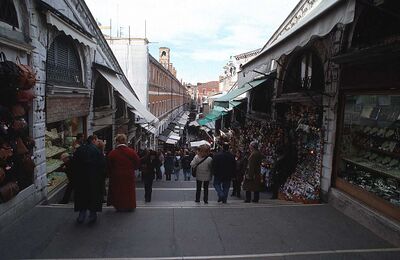Rialto: Difference between revisions
Created page with "The Ponte di Rialto (Rialto Bridge) is one of the most famous bridges in all of Venice. It stands as the oldest bridge connecting the two banks of the Grand Canal. [[Imag..." |
Sccrymsc5813 (talk | contribs) No edit summary |
||
| Line 1: | Line 1: | ||
The Ponte di Rialto (Rialto Bridge) is | The Ponte di Rialto (Rialto Bridge) is the oldest bridge in Venice that crosses over the Grand Canal. This bridge is the connection between the districts of San Polo and San Marco, and replaced a wooden bridge that contained a mobile center which allowed for ships crossing throughout the day. The current Rialto Bridge was made out of stone and was constructed between the years of 1588 and 1591 under the direction of Antonio de Ponte. The bridge is made of two inclined ramps on either end that come to a flat surface in the middle where pedestrians can gather and look out at the city from all angles. | ||
[[Image:Catanese_Rialto2.jpg|thumb|right|400px| The Rialto lit at night]] | [[Image:Catanese_Rialto2.jpg|thumb|right|400px| The Rialto lit at night]] | ||
== Before it was Built == | == Before it was Built == | ||
Revision as of 03:27, 22 October 2013
The Ponte di Rialto (Rialto Bridge) is the oldest bridge in Venice that crosses over the Grand Canal. This bridge is the connection between the districts of San Polo and San Marco, and replaced a wooden bridge that contained a mobile center which allowed for ships crossing throughout the day. The current Rialto Bridge was made out of stone and was constructed between the years of 1588 and 1591 under the direction of Antonio de Ponte. The bridge is made of two inclined ramps on either end that come to a flat surface in the middle where pedestrians can gather and look out at the city from all angles.

Before it was Built
For centuries, Venice has been a central hub for shipping trade throughout the World. Shipping via cargo ships was made easy in a city built on many islands separated by canals. Before the thirteenth century the only way to cross the canals of Venice was to cross on wooden boards laid down in the canal connecting the two banks. At this point there was no way to cross the Grand Canal of Venice until the Venetians began building wooden bridges. Until the sixteenth century the only way to cross the Grand Canal on foot was across wooden bridges which would quickly wear down and become unstable.
Construction

In the 1500’s La Serenissima called upon architect Antonio Da Ponte to build a bridge connecting the two banks. Two famous architects Andrea Palladio and Vincenzo Scamozzi made a bid for the contract of the bridge before it was given to Antonio Da Ponte. Andrea Palladio and Vincenzo Scamozzi each wanted to build a bridge with three large arches with a kettledrum in the center supported by columns, but Antonio Da Ponte decided to create a structure similar to the previous wooden bridges crossing the Grand Canal. The structure of the old wooden bridges was formed by two ramps leading over the canal meeting at a portico.

Construction of the Rialto Bridge began in 1588 and proved to be a difficult task due to the depth of the sea bottom and other various conditions of instability. In 1591, three years after construction began, the bridge was finally finished.
For over two hundred and fifty years the Rialto Bridge remained the only way to cross the Grand Canal on foot, until the Ponte dell'Accademia was constructed in 1854.
Today
The twenty two meter wide Rialto Bridge offers two walkways on the outskirts of the bridge and a larger central walkway which leads between two rows of shops who thrive upon tourist trade. The Ponte di Rialto is now one of the most famous tourist attractions, and one of the largest staples of Venetian history.